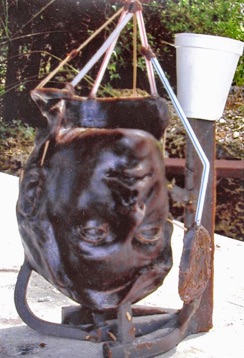Bronze Casting Process
The process documented below is the “lost wax” process, which has been used for casting bronze since c. 3000 BC. The pictures were taken at the foundry at the University of Miami. Freda now teaches bronze casting at Miami-Dade College, Kendall campus. For more information, contact her at the email address on the Home page.
A model is first made in wax, then “invested” or encased in a refractory material. In this case the investment is plaster, silica sand, and perlite and is known as “traditional” investment. The investment is then placed in a kiln where the wax is melted and burned out. The hollow left in the investment is the exact negative of the original . Molten bronze is poured into that hollow and duplicates the shape of the wax. After the bronze cools, the investment is broken open, the sprues cut off, the surface restored, and a patina applied to color and protect the finish of the bronze.














